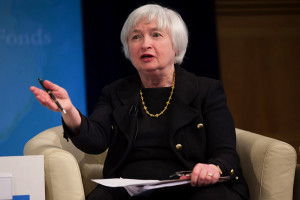By Peter Ward November 30, 2015
Pfizer Finalizes $160bn Allergen Deal

Drugs ©Charles Kaiser
U.S. pharmaceuticals giant Pfizer announced a $160 billion deal to merge with Botox-maker Allergan last week. The acquisition is the largest in history for the pharmaceuticals industry.
The takeover was almost immediately criticized by U.S. politicians, who claim the deal is an attempt by Pfizer to cut its tax bill. If the merger is approved by regulators, it would be the biggest example yet of tax inversion, where a large U.S. multinational merges with a (usually much smaller) firm in a country with a lower tax rate in order to move its headquarters there.
Pfizer is expected to transfer its headquarters to Dublin, where Allergan is based, when the merger goes through. Ireland’s corporate tax rate stands at 12.5%, compared with the 35% Pfizer currently pays in the U.S.
Hillary Clinton, Senator Bernie Sanders and Republican candidate Donald Trump have all spoken out against the merger, with Clinton accusing Pfizer of avoiding its “fair share” of taxes.
The Obama administration has stepped up efforts to curb tax inversions through regulation, and two weeks ago, the U.S. Treasury announced its intention to crack down on the tax evasion strategy.
Still, the Pfizer deal will likely be exempt from any ruling, according to experts quoted by USA Today. The merger is technically structured so that Allergan, the smaller company, is the acquirer. Allergan shareholders would own 44% of the combined company and Pfizer shareholders would own 56%. U.S. tax codes require Pfizer’s ownership to be 60% or higher for the deal to qualify as tax inversion.
The New York Times claims the deal has the potential to force change in the system of taxing multinational companies in the U.S.
Investors Could Waste $2.2 Trillion on Fossil Fuels: Report

Oil train, © Russ Allison Loar
Fossil fuel companies could waste more than $2 trillion worth of investor money over the next decade, on projects that will be creates new supply for which there is no demand, a report published on Tuesday suggests.
The research, by the green think tank Carbon Tracker, states that global action on climate change and an increase in clean energy will leave $2.2 trillion worth of projects unable to sell the fossil fuels they produce as the market for fossil fuels shrinks.
The U.S. has the greatest exposure to the risks, according to the report, with $412 billion of projects potentially producing unmarketable energy, according to the report. Canada has the second highest risk ($220 billion), followed by China ($179 billion) and Australia ($103 billion). The research also found that Shell, ExxonMobil and Pemex are the companies most at risk, with over $70 billion of investments in capacity for which there will be no market.
“If the industry misreads future demand by underestimating technology and policy advances, this can lead to an excess of supply and create stranded assets,” says the report. “This is where shareholders should be concerned – if companies are committing to future production which may never generate the returns expected.”
U.S. Among Most Unequal Economies

Pope Francis has sharply criticized growing economic inequality and unfettered markets. Here pictured meeting former speaker of the U.S. House of Representatives in September. ©
Speaker John Boehner
A new report from Morgan Stanley, published on Wednesday, has revealed the most unequal economies in the developed world are in Southern Europe, closely followed by the U.S.
Bloomberg reports analysts at the bank looked at inequality indicators such as the gender pay gap, Internet access and involuntary part time employment. Portugal was ranked the most unequal developed country, followed by Italy, Greece, Spain and then the U.S.
The bank also stated that persistent economic inequality hinders long-term growth. As access to opportunity is hindered, people are less incentivized to work hard, get more education and improve their skills, according to the report. Economic inequalities also undermine trust in policy makers and social institutions and lead to increased market regulation and anti-immigration measures.
“Past generations of middle-class families, emerging from the post-WWII period, could aspire to improving living standards, with a reasonably sized house, a good education for their children” and dependable pensions, Morgan Stanley economists said in their report Tuesday. “In contrast, middle-class aspirations are now running up against the wall of job and retirement insecurity.”
U.S. Economic Growth Revised Up

Federal Reserve Chairman Janet Yellen ©International Monetary Fund
The U.S. economy grew at a faster rate in the third quarter of the year than was previously reported, as the Commerce Department revised its previous estimate on Tuesday.
The overall economy grew at an annual rate of 2.1% in the three-month period that runs from July through September, according to the new report. That’s up from the 1.5% previously reported for the quarter. GDP grew 3.9% in the second quarter of the year, and just 0.6% in the first quarter.
The third quarter growth figure was revised primarily because businesses were found to have restocked inventories at a faster pace than was estimated originally.
The revised number will likely fuel speculation that the Federal Reserve will raise interest rates in December. The Fed has been delaying an interest-rate hike until economic conditions stabilized. Economists are forecasting growth to accelerate to around 2.5% in the fourth quarter, due to stronger consumer spending.
Thanksgiving Flights Data

Thanksgiving feast. ©Sharon Mollerus
On Monday The New York Times published an interactive graphic that analyzed where Americans planned to travel over the Thanksgiving holiday. The data, taken from Google Flights, showed the cities in the U.S. that were the most popular destinations for Thanksgiving vacations.
The accompanying article noted that vacation destinations such as Miami and Las Vegas had the largest influxes of visitors for this Thanksgiving week.
The graphic gives an overview of the major cities of the U.S. and shows the flow in and out of them over the holiday period. Users are then able to hover over specific cities to see a more clear view of how many people are flying into and out of that particular city.
Miami is set to enjoy the biggest increase of visitors this week, closely followed by Orlando, according to the data. The biggest portion of travelers comes from Boston, Washington and Atlanta. More people are flying from Boston than any other destination, perhaps due to the large number of colleges in the area. The article also details when the most popular times for people to fly are.
This entry was posted on Monday, November 30th, 2015 at 7:00 am. It is filed under Week in Review and tagged with carbon tracker, corporate inversion, economic growth, fossil fuel projects, income inequality, Pfizer Allergen deal, Thanksgiving flights. You can follow any responses to this entry through the RSS 2.0 feed.
Comments are closed.
